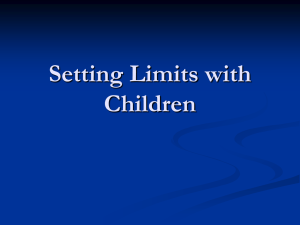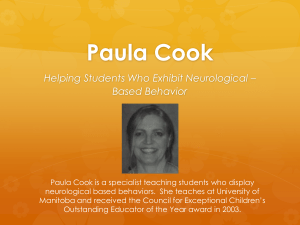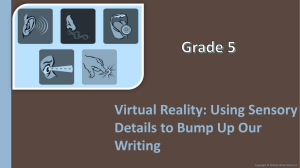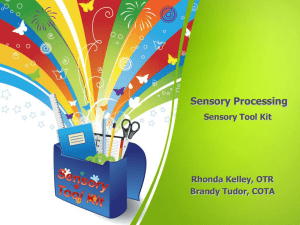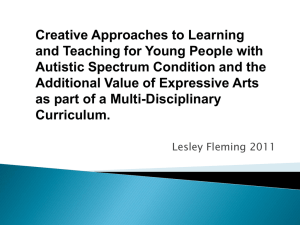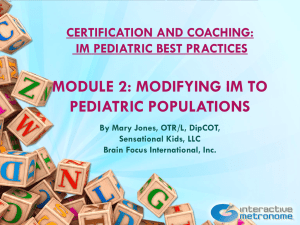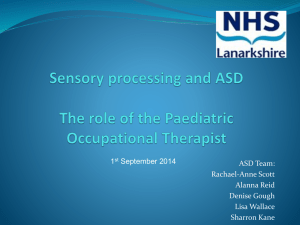Sensory Solutions for Children at School and Home
advertisement
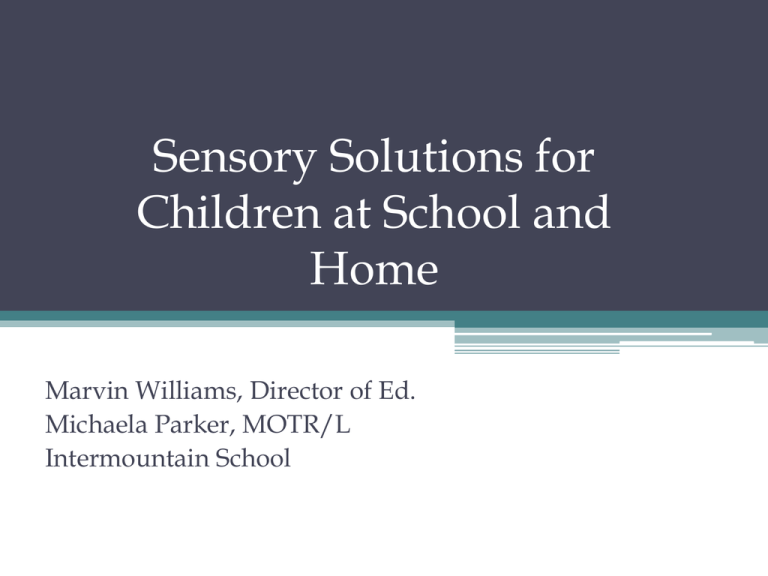
Sensory Solutions for Children at School and Home Marvin Williams, Director of Ed. Michaela Parker, MOTR/L Intermountain School What is Sensory Integration? • Sensory integration is the organization of sensation for use. Our senses give us information about the physical conditions of our body and the environment around us. ▫ Jean Ayres • The brain must organize all of these sensations to function successfully in our daily activities. Neurodevelopment • How the brain receives and interprets information • Five main senses ▫ Taste, touch, smell, vision, hearing • Two other senses important ▫ Vestibular (Movement Sense) ▫ Proprioception (Muscle Sense) Intermountain and SI • Emotionally Challenged ▫ Reactive Attachment Disorder ▫ Autistic Disorder ▫ Sensory Processing Disorder • Goal is to promote children’s ability to know their sensory needs and how to address them on their own. Stress and Anxiety Effects on Sensory Processing • A child’s ability to successfully process sensory information is greatly interrupted by stress and anxiety. ▫ Symptoms of Anxiety: Sweating, Loss of Appetite, Headaches, Tremors, Butterflies in Stomach, etc. • Stress prevents the creation of learning and memory. Occupational Therapy and SI • OT will evaluate a child’s sensory processing skills to determine if intervention is necessary. ▫ Ex: Sensory Profile • OT can provide specific interventions to address a child’s sensory processing needs. ▫ Ex: How Does Your Engine Run Sensory Diets • School ▫ Goal is for child to use sensory diet to identify their individual sensory needs to enhance their success as a student. • Home ▫ Goal is for child to use sensory diet as part of their daily routine to have more positive and safe experiences every day. Learning Through Movement • Heavy Work • Physical Activity • Movement breaks Gum and Fidgets • Gum ▫ Gum can be GOOD! Oral motor movement Deep pressure to jaw • Fidgets ▫ Squishy ball, pencil toppers Anything with texture ▫ Rules for fidgets Calming Strategies and Centers • Devoted time and space for students to calm their nervous systems ▫ ▫ ▫ ▫ Light dimmers, turn down light Slow swinging Tightly wrapped in a blanket Headphones/Soothing music Calming Strategies, Cont. • Deep Pressure ▫ ▫ ▫ ▫ Dots and Squeezes (joint compressions) Quiet corner with large pillow/bean bag to lie on Weighted Items Sit in an adult’s lap From Classroom to Home • Routines ▫ Starting day ▫ Ending day • Transitions ▫ ▫ ▫ ▫ Visual timers Sounds cues Musical interludes Countdown from 5 (or 20!) BAL – A – VIS – X (BAVX) B-rhythmic balance Auditory Vision; eXercise Originated by Bill Hubert What is Bal-A-Vis-X? • A series of Balance / Auditory / Vision exercises that are rooted in rhythm • Exercises that require full-body coordination • Necessitates “focused” attention Who Benefits from BAVX? • Children and adults who are: ▫ Learning Disabled: cognitive integration improves. ▫ Behaviorally disordered: “settles”. ▫ Diagnosed with ADD / ADHD: attention becomes more focused. ▫ Gifted: coordination improves and stress headaches diminish. ▫ Non disabled: academic achievement improves. BAVX: founder Bill Hubert • • • • • Teacher for 30+ years – English and reading. Tutor for math, ADHD, writing and reading. Upward Bound summer teacher. Martial arts instructor. Runs a BAVX lab for 7th graders at Hadley Middle School in Wichita, Kansas. So – what did Bill see? • Inability to control eyes, focus attention, sit or stand without moving • Illegible handwriting • Stiff/locked posture while sitting, standing, walking or running • Rhythm less gait while walking or running • Difficulty in distinguishing left from right • Often unclear handedness • General clumsiness • Mental and/or physical apathy BAVX – Exercises • Exercises are not just for the athlete or daring. They are for everyone! • First graders are capable of more than half of them. • Nine-year-olds can master all but the most intricate. • The non-athletic and physically challenged find BAVX well within their ability range. • At least 75% of all exercises can be done while seated. Quotes • Movement is the door to learning – Paul Dennison • The more you move your hands, the more the brain grows – Carla Hannaford • The ear choreographs the body’s dance of balance, rhythm, and movement - Don Campbell Resources • • • • • • • Out of Sync Child Sensory Integration and the Child How Does your Engine Run? Sensory Profile S’cool Moves DSM-IV-TR BAVX – Bill Hubert developer ▫ phone: 316-722-8012 ▫ email: bill@bal-a-vis-x.com




